Financial Accounting Assignment: Scenario Analysis and Solutions
VerifiedAdded on 2022/11/29
|26
|4721
|263
Homework Assignment
AI Summary
This document presents a comprehensive solution to a financial accounting assignment. It begins with an introduction to financial accounting, defining its core processes of recording, evaluating, and reporting financial transactions, including the preparation of financial statements like the balance sheet and cash flow report. The solution then delves into two scenarios, addressing questions on various accounting operations, including sales, acquisitions, and cash transactions. It differentiates between single-entry and double-entry bookkeeping systems and explains the importance of trial balances in ensuring the accuracy and reliability of financial data. The assignment also explores journal entries, providing examples and ledger accounts, and discusses the income statement and balance sheet, outlining their components and the requirements of financial reports for different users, such as management, creditors, and employees. Finally, the document includes profit and loss accounts and a balance sheet for the year ended 31st December 2017, offering a complete overview of the financial accounting concepts and their practical application.
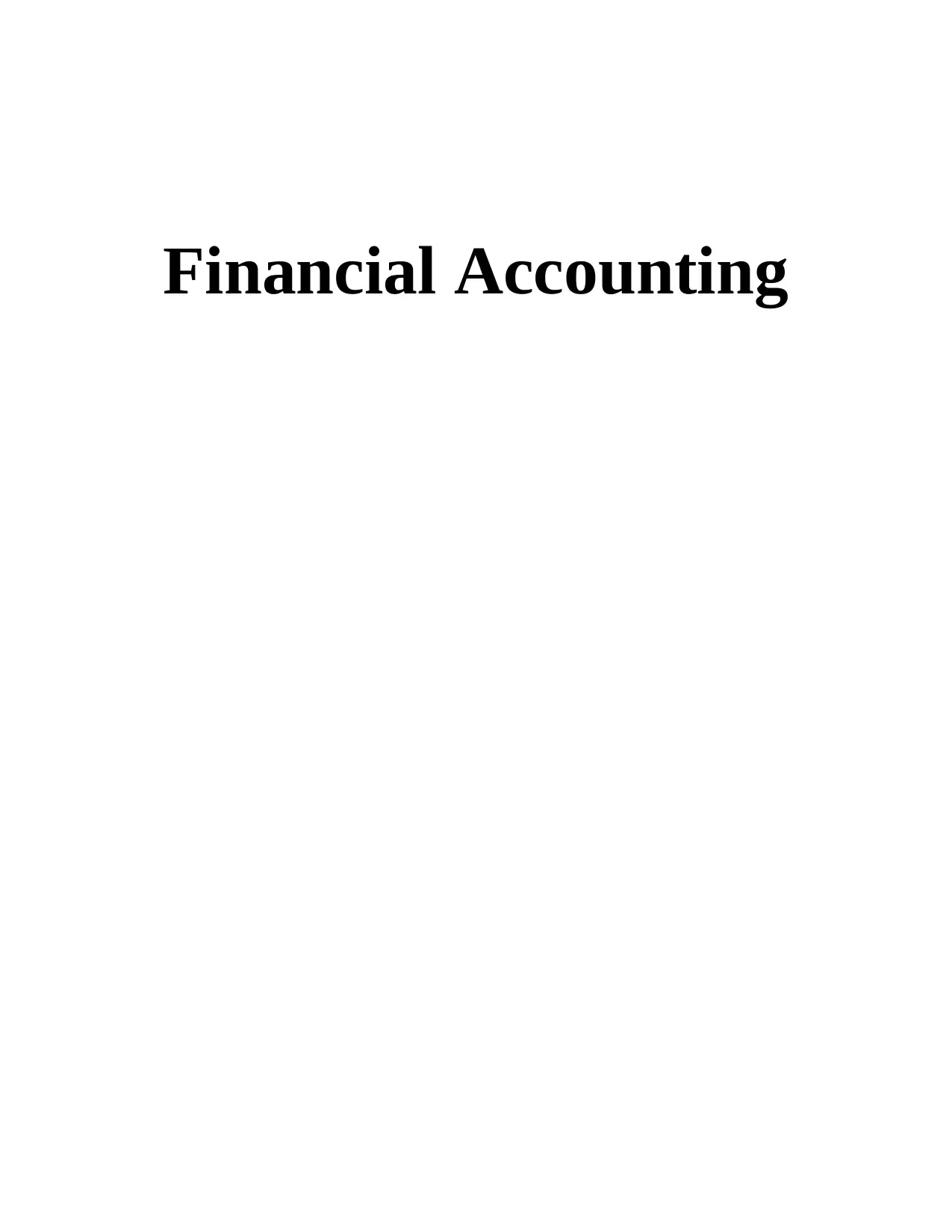
Financial Accounting
Paraphrase This Document
Need a fresh take? Get an instant paraphrase of this document with our AI Paraphraser
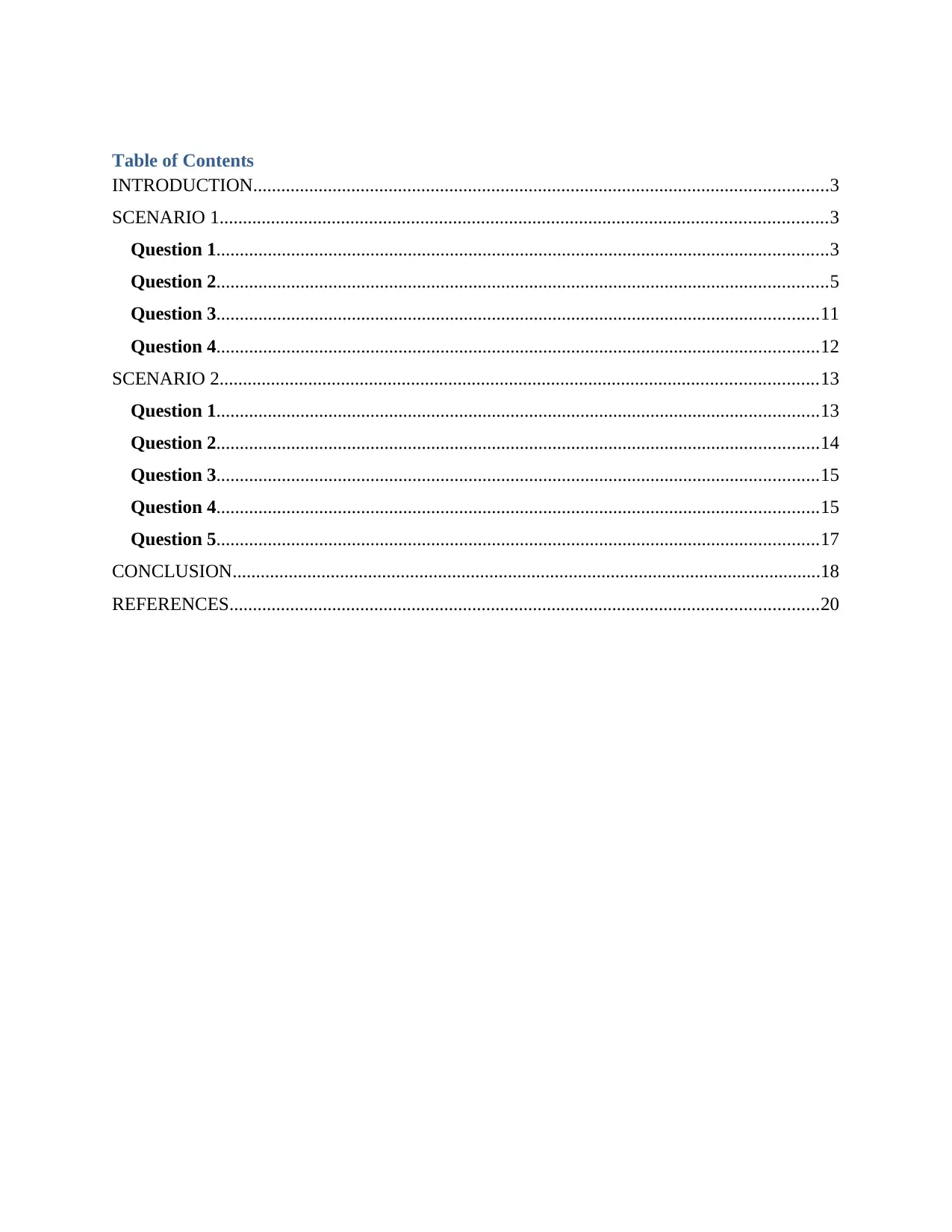
Table of Contents
INTRODUCTION...........................................................................................................................3
SCENARIO 1..................................................................................................................................3
Question 1...................................................................................................................................3
Question 2...................................................................................................................................5
Question 3.................................................................................................................................11
Question 4.................................................................................................................................12
SCENARIO 2................................................................................................................................13
Question 1.................................................................................................................................13
Question 2.................................................................................................................................14
Question 3.................................................................................................................................15
Question 4.................................................................................................................................15
Question 5.................................................................................................................................17
CONCLUSION..............................................................................................................................18
REFERENCES..............................................................................................................................20
INTRODUCTION...........................................................................................................................3
SCENARIO 1..................................................................................................................................3
Question 1...................................................................................................................................3
Question 2...................................................................................................................................5
Question 3.................................................................................................................................11
Question 4.................................................................................................................................12
SCENARIO 2................................................................................................................................13
Question 1.................................................................................................................................13
Question 2.................................................................................................................................14
Question 3.................................................................................................................................15
Question 4.................................................................................................................................15
Question 5.................................................................................................................................17
CONCLUSION..............................................................................................................................18
REFERENCES..............................................................................................................................20
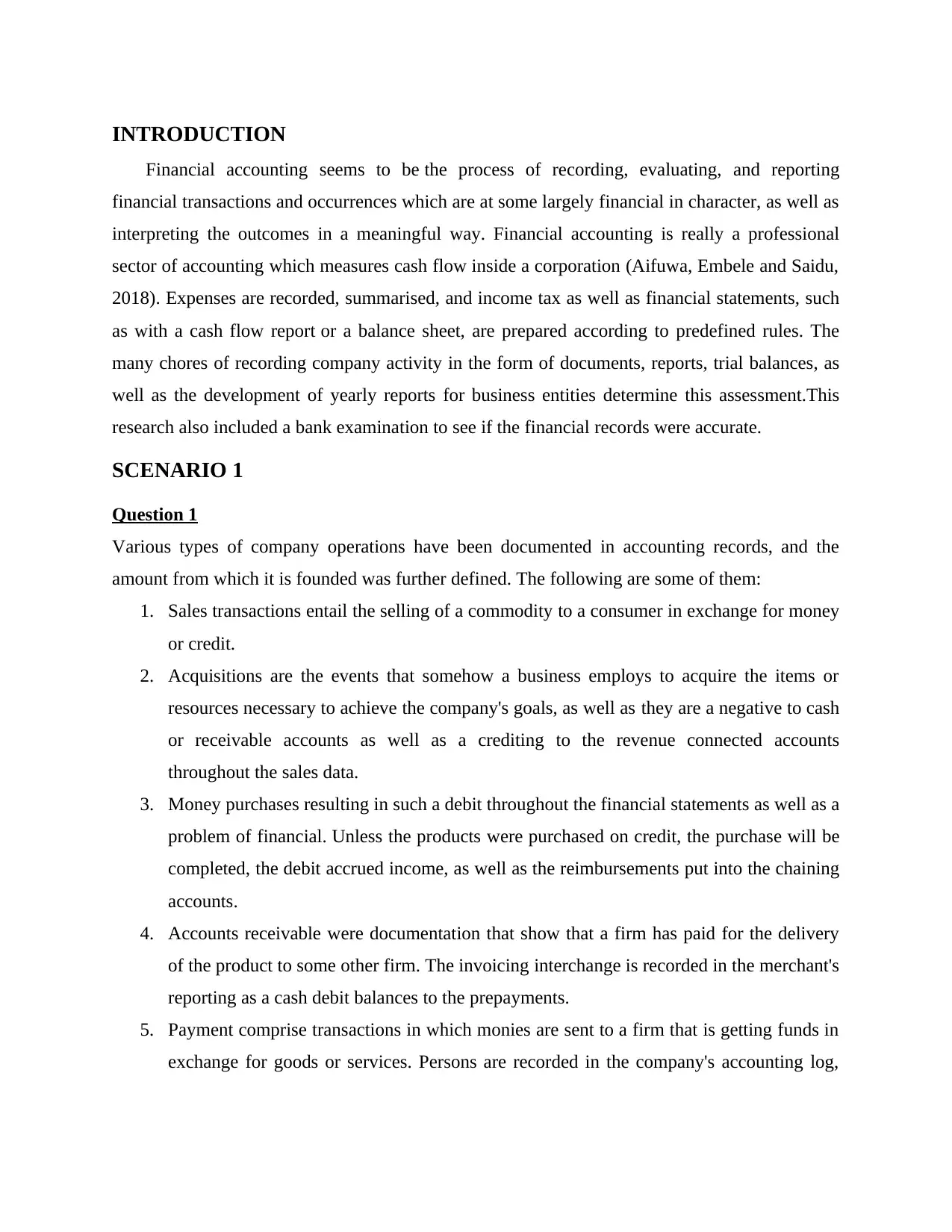
INTRODUCTION
Financial accounting seems to be the process of recording, evaluating, and reporting
financial transactions and occurrences which are at some largely financial in character, as well as
interpreting the outcomes in a meaningful way. Financial accounting is really a professional
sector of accounting which measures cash flow inside a corporation (Aifuwa, Embele and Saidu,
2018). Expenses are recorded, summarised, and income tax as well as financial statements, such
as with a cash flow report or a balance sheet, are prepared according to predefined rules. The
many chores of recording company activity in the form of documents, reports, trial balances, as
well as the development of yearly reports for business entities determine this assessment.This
research also included a bank examination to see if the financial records were accurate.
SCENARIO 1
Question 1
Various types of company operations have been documented in accounting records, and the
amount from which it is founded was further defined. The following are some of them:
1. Sales transactions entail the selling of a commodity to a consumer in exchange for money
or credit.
2. Acquisitions are the events that somehow a business employs to acquire the items or
resources necessary to achieve the company's goals, as well as they are a negative to cash
or receivable accounts as well as a crediting to the revenue connected accounts
throughout the sales data.
3. Money purchases resulting in such a debit throughout the financial statements as well as a
problem of financial. Unless the products were purchased on credit, the purchase will be
completed, the debit accrued income, as well as the reimbursements put into the chaining
accounts.
4. Accounts receivable were documentation that show that a firm has paid for the delivery
of the product to some other firm. The invoicing interchange is recorded in the merchant's
reporting as a cash debit balances to the prepayments.
5. Payment comprise transactions in which monies are sent to a firm that is getting funds in
exchange for goods or services. Persons are recorded in the company's accounting log,
Financial accounting seems to be the process of recording, evaluating, and reporting
financial transactions and occurrences which are at some largely financial in character, as well as
interpreting the outcomes in a meaningful way. Financial accounting is really a professional
sector of accounting which measures cash flow inside a corporation (Aifuwa, Embele and Saidu,
2018). Expenses are recorded, summarised, and income tax as well as financial statements, such
as with a cash flow report or a balance sheet, are prepared according to predefined rules. The
many chores of recording company activity in the form of documents, reports, trial balances, as
well as the development of yearly reports for business entities determine this assessment.This
research also included a bank examination to see if the financial records were accurate.
SCENARIO 1
Question 1
Various types of company operations have been documented in accounting records, and the
amount from which it is founded was further defined. The following are some of them:
1. Sales transactions entail the selling of a commodity to a consumer in exchange for money
or credit.
2. Acquisitions are the events that somehow a business employs to acquire the items or
resources necessary to achieve the company's goals, as well as they are a negative to cash
or receivable accounts as well as a crediting to the revenue connected accounts
throughout the sales data.
3. Money purchases resulting in such a debit throughout the financial statements as well as a
problem of financial. Unless the products were purchased on credit, the purchase will be
completed, the debit accrued income, as well as the reimbursements put into the chaining
accounts.
4. Accounts receivable were documentation that show that a firm has paid for the delivery
of the product to some other firm. The invoicing interchange is recorded in the merchant's
reporting as a cash debit balances to the prepayments.
5. Payment comprise transactions in which monies are sent to a firm that is getting funds in
exchange for goods or services. Persons are recorded in the company's accounting log,
⊘ This is a preview!⊘
Do you want full access?
Subscribe today to unlock all pages.

Trusted by 1+ million students worldwide
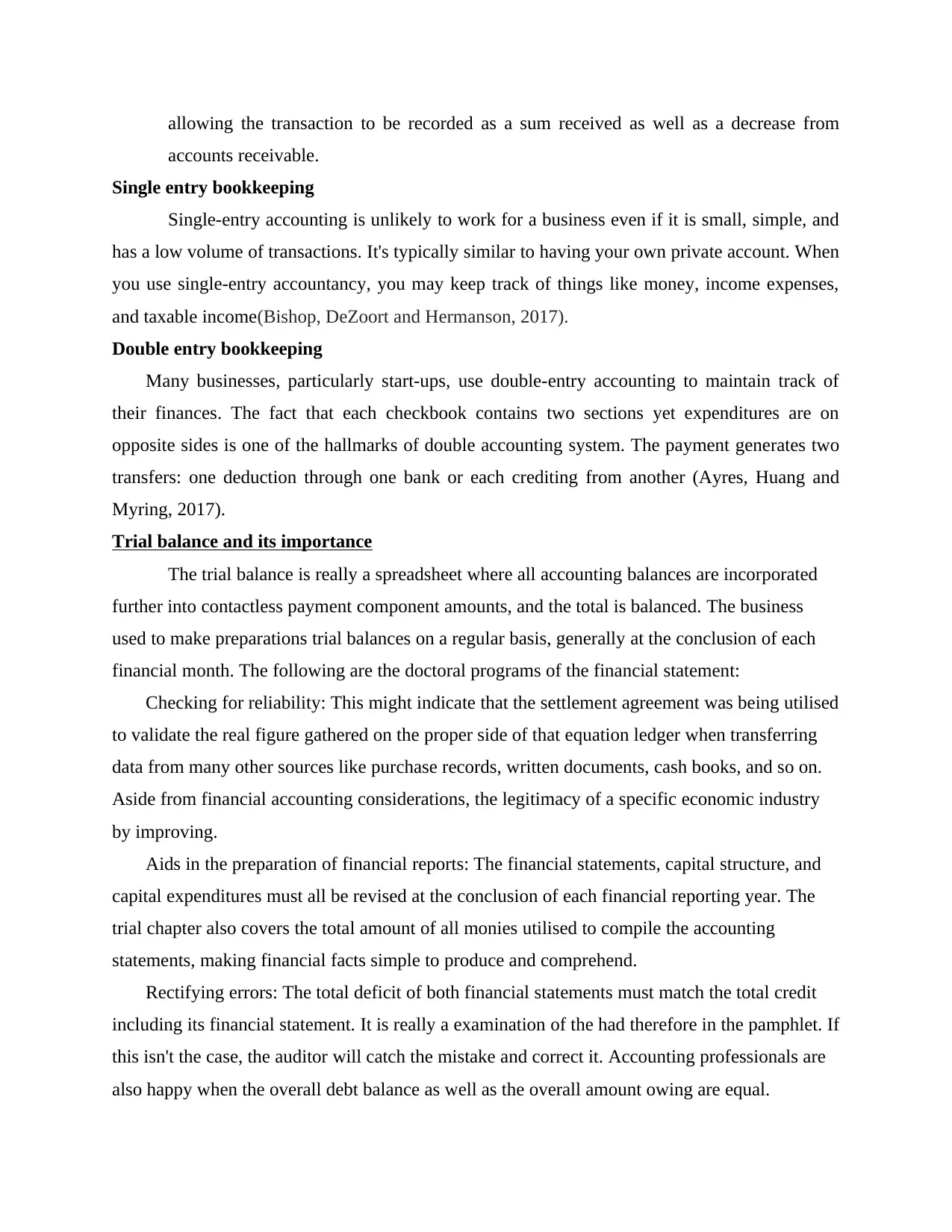
allowing the transaction to be recorded as a sum received as well as a decrease from
accounts receivable.
Single entry bookkeeping
Single-entry accounting is unlikely to work for a business even if it is small, simple, and
has a low volume of transactions. It's typically similar to having your own private account. When
you use single-entry accountancy, you may keep track of things like money, income expenses,
and taxable income(Bishop, DeZoort and Hermanson, 2017).
Double entry bookkeeping
Many businesses, particularly start-ups, use double-entry accounting to maintain track of
their finances. The fact that each checkbook contains two sections yet expenditures are on
opposite sides is one of the hallmarks of double accounting system. The payment generates two
transfers: one deduction through one bank or each crediting from another (Ayres, Huang and
Myring, 2017).
Trial balance and its importance
The trial balance is really a spreadsheet where all accounting balances are incorporated
further into contactless payment component amounts, and the total is balanced. The business
used to make preparations trial balances on a regular basis, generally at the conclusion of each
financial month. The following are the doctoral programs of the financial statement:
Checking for reliability: This might indicate that the settlement agreement was being utilised
to validate the real figure gathered on the proper side of that equation ledger when transferring
data from many other sources like purchase records, written documents, cash books, and so on.
Aside from financial accounting considerations, the legitimacy of a specific economic industry
by improving.
Aids in the preparation of financial reports: The financial statements, capital structure, and
capital expenditures must all be revised at the conclusion of each financial reporting year. The
trial chapter also covers the total amount of all monies utilised to compile the accounting
statements, making financial facts simple to produce and comprehend.
Rectifying errors: The total deficit of both financial statements must match the total credit
including its financial statement. It is really a examination of the had therefore in the pamphlet. If
this isn't the case, the auditor will catch the mistake and correct it. Accounting professionals are
also happy when the overall debt balance as well as the overall amount owing are equal.
accounts receivable.
Single entry bookkeeping
Single-entry accounting is unlikely to work for a business even if it is small, simple, and
has a low volume of transactions. It's typically similar to having your own private account. When
you use single-entry accountancy, you may keep track of things like money, income expenses,
and taxable income(Bishop, DeZoort and Hermanson, 2017).
Double entry bookkeeping
Many businesses, particularly start-ups, use double-entry accounting to maintain track of
their finances. The fact that each checkbook contains two sections yet expenditures are on
opposite sides is one of the hallmarks of double accounting system. The payment generates two
transfers: one deduction through one bank or each crediting from another (Ayres, Huang and
Myring, 2017).
Trial balance and its importance
The trial balance is really a spreadsheet where all accounting balances are incorporated
further into contactless payment component amounts, and the total is balanced. The business
used to make preparations trial balances on a regular basis, generally at the conclusion of each
financial month. The following are the doctoral programs of the financial statement:
Checking for reliability: This might indicate that the settlement agreement was being utilised
to validate the real figure gathered on the proper side of that equation ledger when transferring
data from many other sources like purchase records, written documents, cash books, and so on.
Aside from financial accounting considerations, the legitimacy of a specific economic industry
by improving.
Aids in the preparation of financial reports: The financial statements, capital structure, and
capital expenditures must all be revised at the conclusion of each financial reporting year. The
trial chapter also covers the total amount of all monies utilised to compile the accounting
statements, making financial facts simple to produce and comprehend.
Rectifying errors: The total deficit of both financial statements must match the total credit
including its financial statement. It is really a examination of the had therefore in the pamphlet. If
this isn't the case, the auditor will catch the mistake and correct it. Accounting professionals are
also happy when the overall debt balance as well as the overall amount owing are equal.
Paraphrase This Document
Need a fresh take? Get an instant paraphrase of this document with our AI Paraphraser
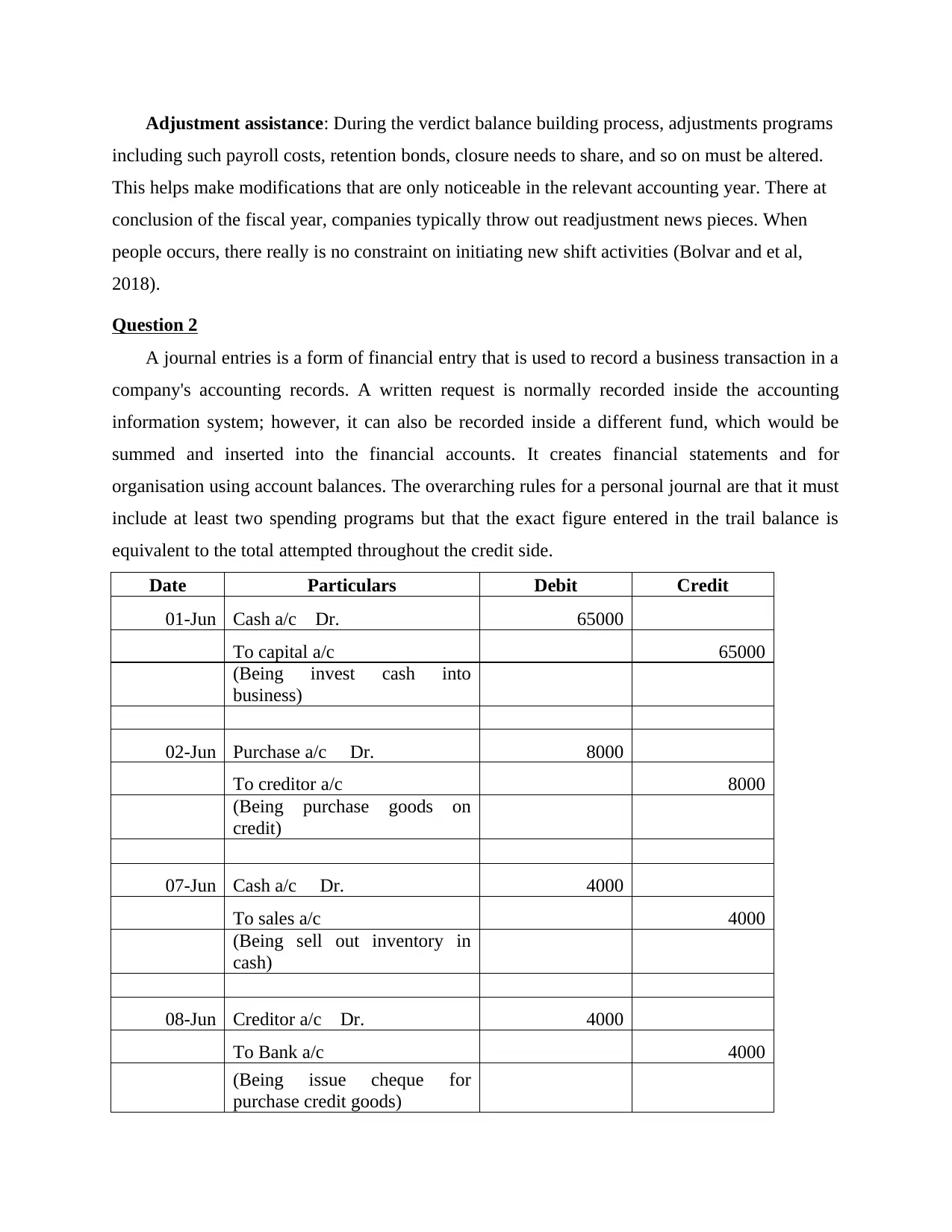
Adjustment assistance: During the verdict balance building process, adjustments programs
including such payroll costs, retention bonds, closure needs to share, and so on must be altered.
This helps make modifications that are only noticeable in the relevant accounting year. There at
conclusion of the fiscal year, companies typically throw out readjustment news pieces. When
people occurs, there really is no constraint on initiating new shift activities (Bolvar and et al,
2018).
Question 2
A journal entries is a form of financial entry that is used to record a business transaction in a
company's accounting records. A written request is normally recorded inside the accounting
information system; however, it can also be recorded inside a different fund, which would be
summed and inserted into the financial accounts. It creates financial statements and for
organisation using account balances. The overarching rules for a personal journal are that it must
include at least two spending programs but that the exact figure entered in the trail balance is
equivalent to the total attempted throughout the credit side.
Date Particulars Debit Credit
01-Jun Cash a/c Dr. 65000
To capital a/c 65000
(Being invest cash into
business)
02-Jun Purchase a/c Dr. 8000
To creditor a/c 8000
(Being purchase goods on
credit)
07-Jun Cash a/c Dr. 4000
To sales a/c 4000
(Being sell out inventory in
cash)
08-Jun Creditor a/c Dr. 4000
To Bank a/c 4000
(Being issue cheque for
purchase credit goods)
including such payroll costs, retention bonds, closure needs to share, and so on must be altered.
This helps make modifications that are only noticeable in the relevant accounting year. There at
conclusion of the fiscal year, companies typically throw out readjustment news pieces. When
people occurs, there really is no constraint on initiating new shift activities (Bolvar and et al,
2018).
Question 2
A journal entries is a form of financial entry that is used to record a business transaction in a
company's accounting records. A written request is normally recorded inside the accounting
information system; however, it can also be recorded inside a different fund, which would be
summed and inserted into the financial accounts. It creates financial statements and for
organisation using account balances. The overarching rules for a personal journal are that it must
include at least two spending programs but that the exact figure entered in the trail balance is
equivalent to the total attempted throughout the credit side.
Date Particulars Debit Credit
01-Jun Cash a/c Dr. 65000
To capital a/c 65000
(Being invest cash into
business)
02-Jun Purchase a/c Dr. 8000
To creditor a/c 8000
(Being purchase goods on
credit)
07-Jun Cash a/c Dr. 4000
To sales a/c 4000
(Being sell out inventory in
cash)
08-Jun Creditor a/c Dr. 4000
To Bank a/c 4000
(Being issue cheque for
purchase credit goods)
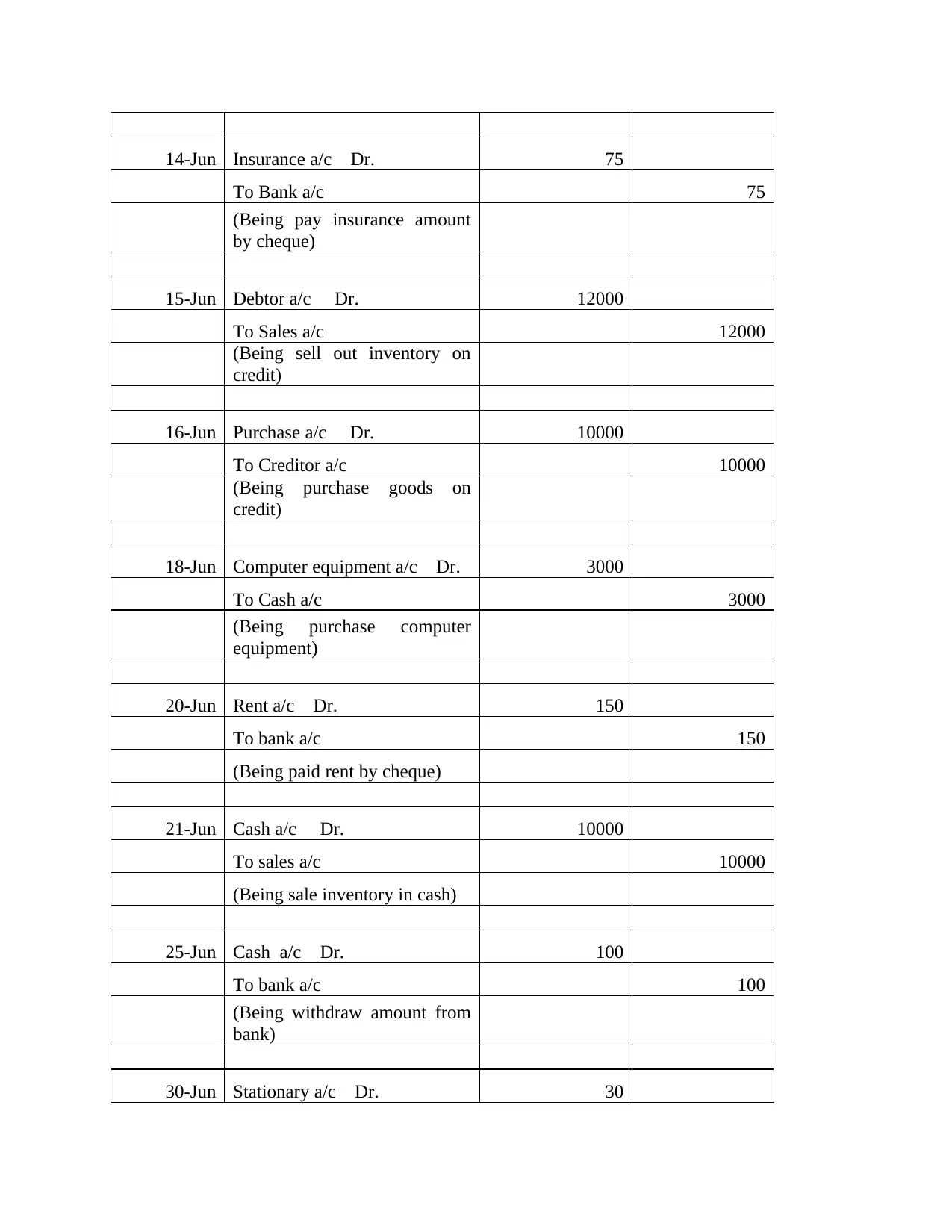
14-Jun Insurance a/c Dr. 75
To Bank a/c 75
(Being pay insurance amount
by cheque)
15-Jun Debtor a/c Dr. 12000
To Sales a/c 12000
(Being sell out inventory on
credit)
16-Jun Purchase a/c Dr. 10000
To Creditor a/c 10000
(Being purchase goods on
credit)
18-Jun Computer equipment a/c Dr. 3000
To Cash a/c 3000
(Being purchase computer
equipment)
20-Jun Rent a/c Dr. 150
To bank a/c 150
(Being paid rent by cheque)
21-Jun Cash a/c Dr. 10000
To sales a/c 10000
(Being sale inventory in cash)
25-Jun Cash a/c Dr. 100
To bank a/c 100
(Being withdraw amount from
bank)
30-Jun Stationary a/c Dr. 30
To Bank a/c 75
(Being pay insurance amount
by cheque)
15-Jun Debtor a/c Dr. 12000
To Sales a/c 12000
(Being sell out inventory on
credit)
16-Jun Purchase a/c Dr. 10000
To Creditor a/c 10000
(Being purchase goods on
credit)
18-Jun Computer equipment a/c Dr. 3000
To Cash a/c 3000
(Being purchase computer
equipment)
20-Jun Rent a/c Dr. 150
To bank a/c 150
(Being paid rent by cheque)
21-Jun Cash a/c Dr. 10000
To sales a/c 10000
(Being sale inventory in cash)
25-Jun Cash a/c Dr. 100
To bank a/c 100
(Being withdraw amount from
bank)
30-Jun Stationary a/c Dr. 30
⊘ This is a preview!⊘
Do you want full access?
Subscribe today to unlock all pages.

Trusted by 1+ million students worldwide
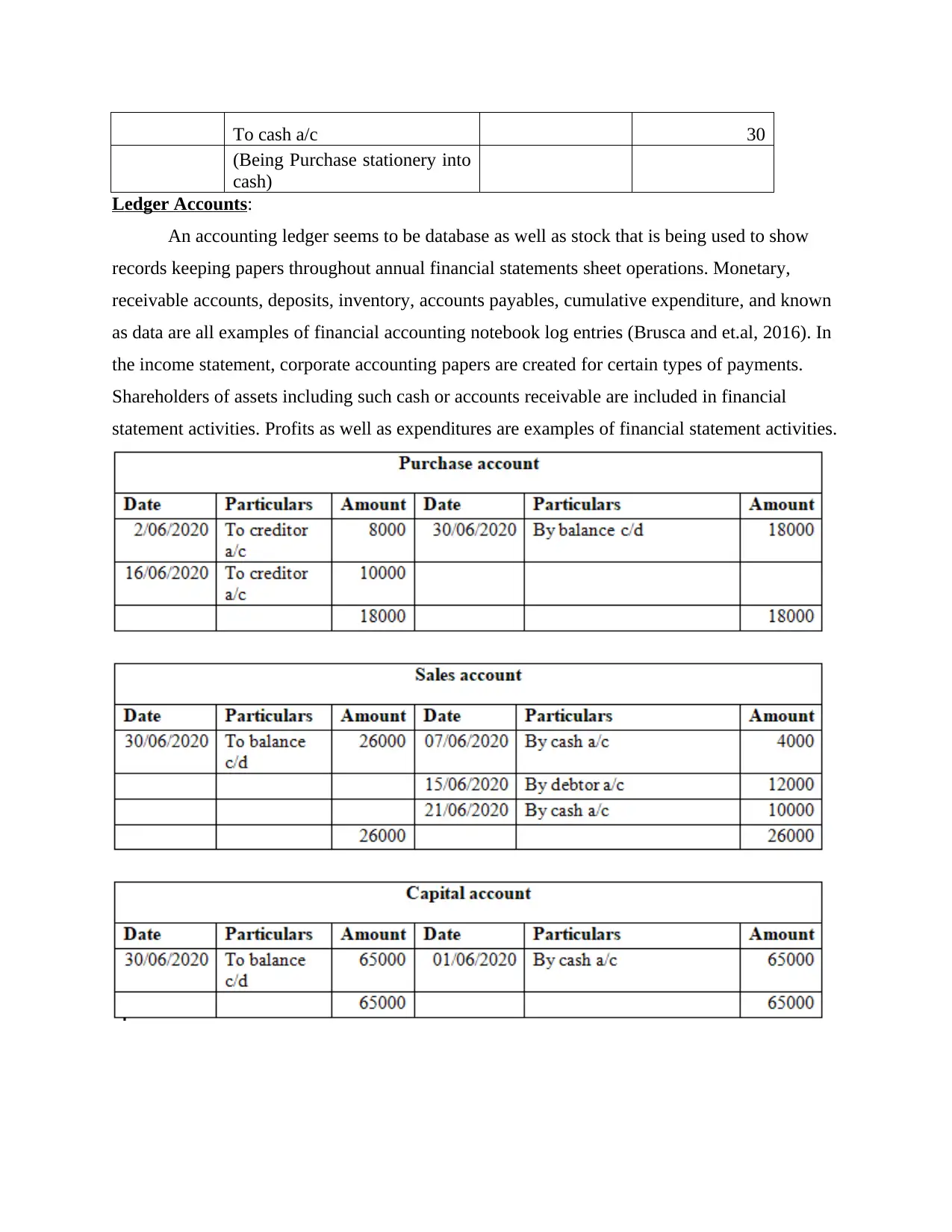
To cash a/c 30
(Being Purchase stationery into
cash)
Ledger Accounts:
An accounting ledger seems to be database as well as stock that is being used to show
records keeping papers throughout annual financial statements sheet operations. Monetary,
receivable accounts, deposits, inventory, accounts payables, cumulative expenditure, and known
as data are all examples of financial accounting notebook log entries (Brusca and et.al, 2016). In
the income statement, corporate accounting papers are created for certain types of payments.
Shareholders of assets including such cash or accounts receivable are included in financial
statement activities. Profits as well as expenditures are examples of financial statement activities.
(Being Purchase stationery into
cash)
Ledger Accounts:
An accounting ledger seems to be database as well as stock that is being used to show
records keeping papers throughout annual financial statements sheet operations. Monetary,
receivable accounts, deposits, inventory, accounts payables, cumulative expenditure, and known
as data are all examples of financial accounting notebook log entries (Brusca and et.al, 2016). In
the income statement, corporate accounting papers are created for certain types of payments.
Shareholders of assets including such cash or accounts receivable are included in financial
statement activities. Profits as well as expenditures are examples of financial statement activities.
Paraphrase This Document
Need a fresh take? Get an instant paraphrase of this document with our AI Paraphraser
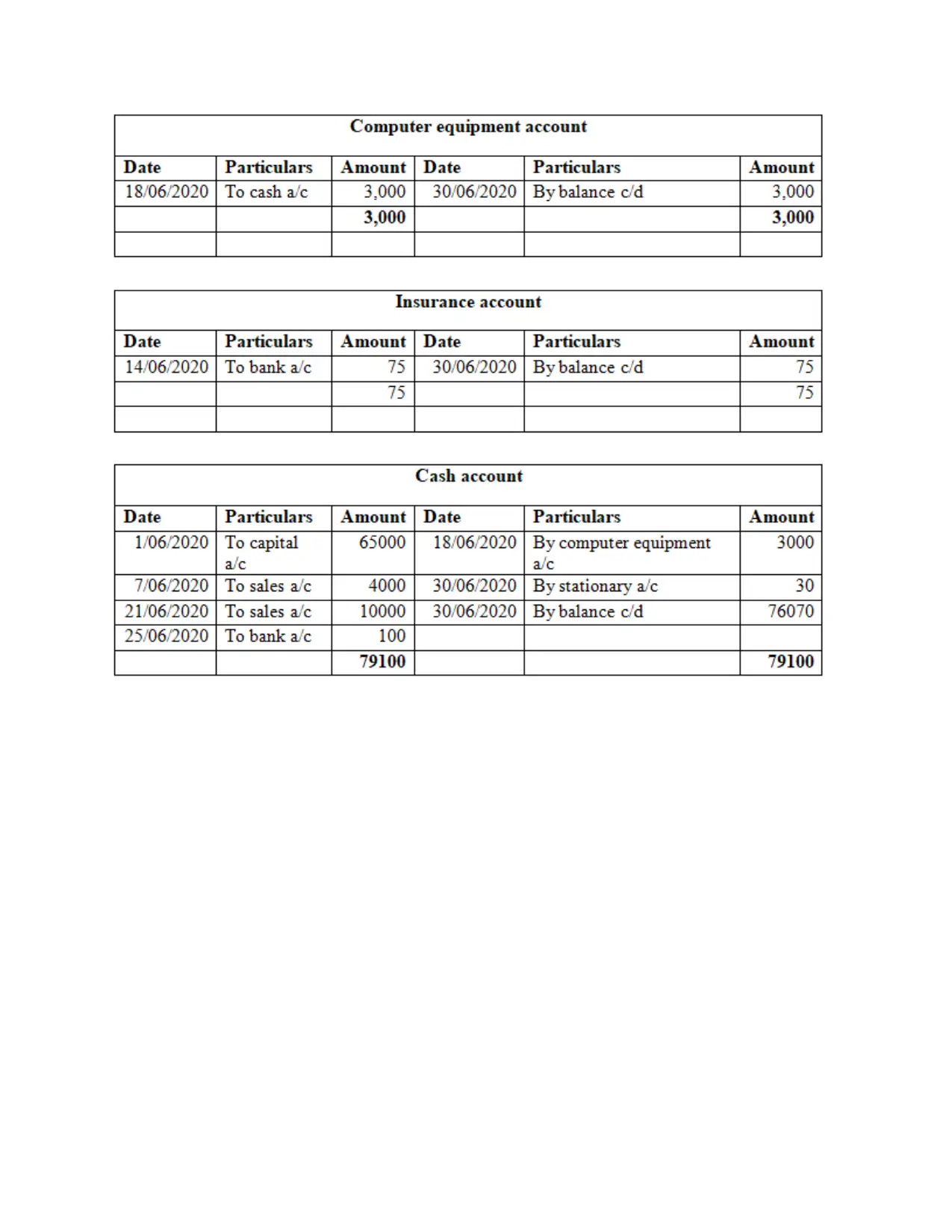
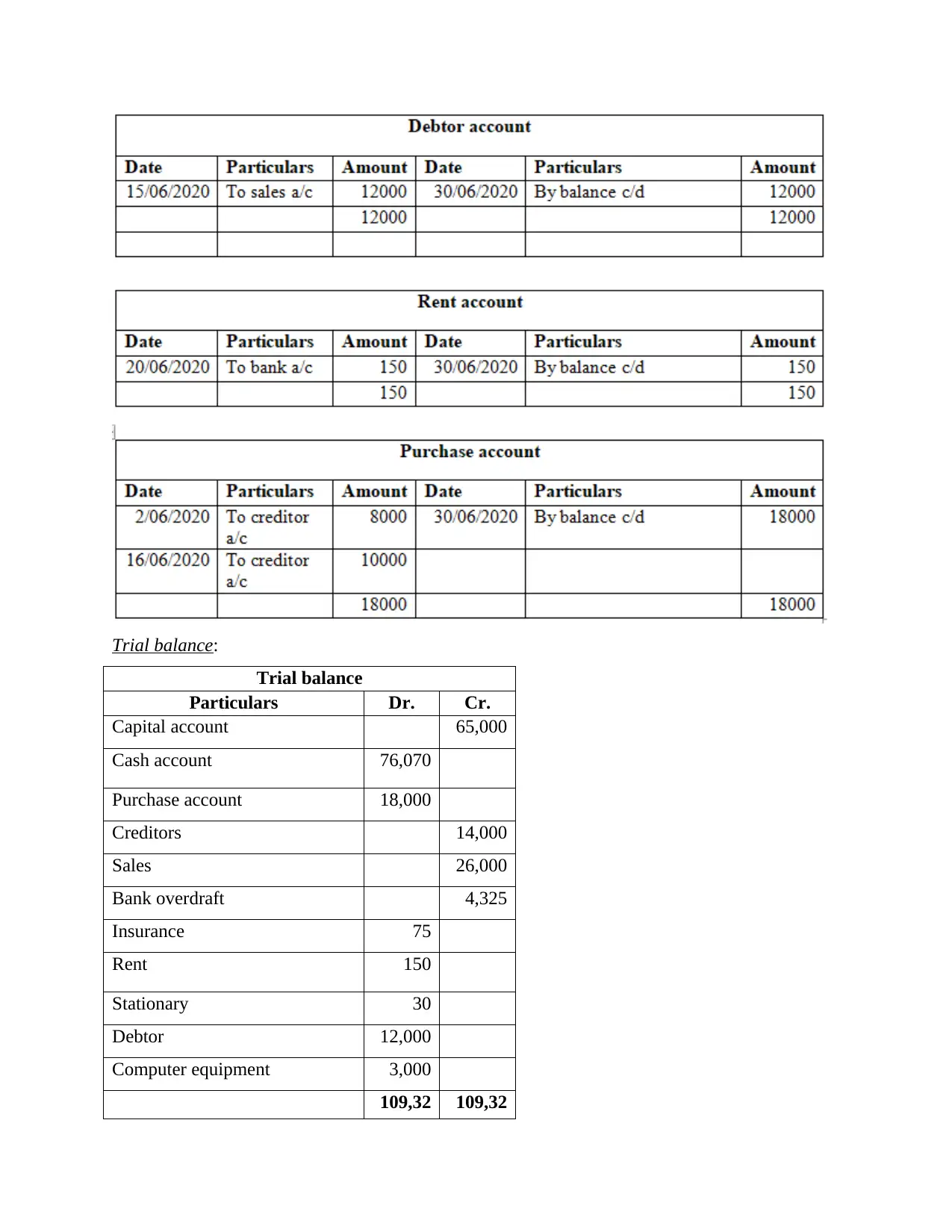
Trial balance:
Trial balance
Particulars Dr. Cr.
Capital account 65,000
Cash account 76,070
Purchase account 18,000
Creditors 14,000
Sales 26,000
Bank overdraft 4,325
Insurance 75
Rent 150
Stationary 30
Debtor 12,000
Computer equipment 3,000
109,32 109,32
Trial balance
Particulars Dr. Cr.
Capital account 65,000
Cash account 76,070
Purchase account 18,000
Creditors 14,000
Sales 26,000
Bank overdraft 4,325
Insurance 75
Rent 150
Stationary 30
Debtor 12,000
Computer equipment 3,000
109,32 109,32
⊘ This is a preview!⊘
Do you want full access?
Subscribe today to unlock all pages.

Trusted by 1+ million students worldwide
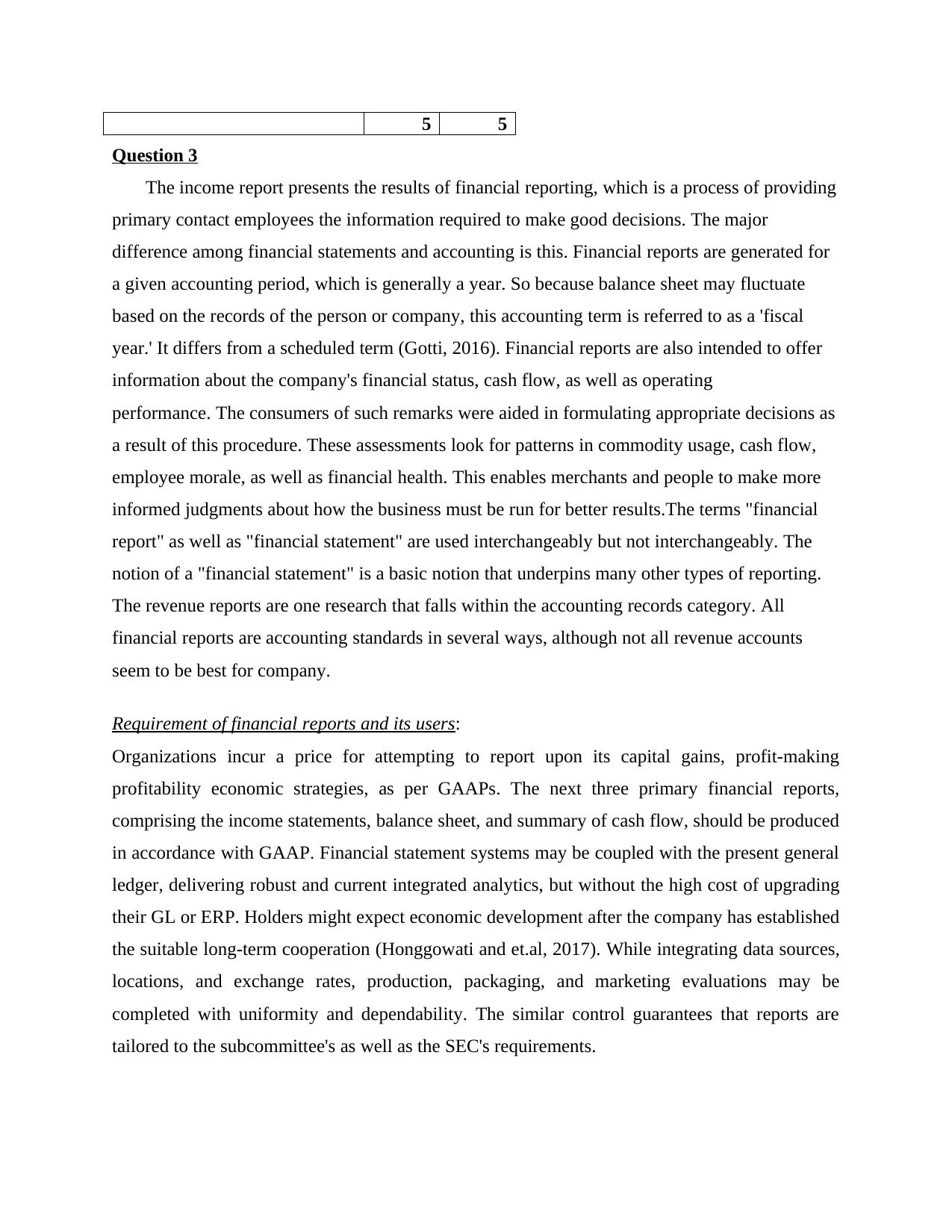
5 5
Question 3
The income report presents the results of financial reporting, which is a process of providing
primary contact employees the information required to make good decisions. The major
difference among financial statements and accounting is this. Financial reports are generated for
a given accounting period, which is generally a year. So because balance sheet may fluctuate
based on the records of the person or company, this accounting term is referred to as a 'fiscal
year.' It differs from a scheduled term (Gotti, 2016). Financial reports are also intended to offer
information about the company's financial status, cash flow, as well as operating
performance. The consumers of such remarks were aided in formulating appropriate decisions as
a result of this procedure. These assessments look for patterns in commodity usage, cash flow,
employee morale, as well as financial health. This enables merchants and people to make more
informed judgments about how the business must be run for better results.The terms "financial
report" as well as "financial statement" are used interchangeably but not interchangeably. The
notion of a "financial statement" is a basic notion that underpins many other types of reporting.
The revenue reports are one research that falls within the accounting records category. All
financial reports are accounting standards in several ways, although not all revenue accounts
seem to be best for company.
Requirement of financial reports and its users:
Organizations incur a price for attempting to report upon its capital gains, profit-making
profitability economic strategies, as per GAAPs. The next three primary financial reports,
comprising the income statements, balance sheet, and summary of cash flow, should be produced
in accordance with GAAP. Financial statement systems may be coupled with the present general
ledger, delivering robust and current integrated analytics, but without the high cost of upgrading
their GL or ERP. Holders might expect economic development after the company has established
the suitable long-term cooperation (Honggowati and et.al, 2017). While integrating data sources,
locations, and exchange rates, production, packaging, and marketing evaluations may be
completed with uniformity and dependability. The similar control guarantees that reports are
tailored to the subcommittee's as well as the SEC's requirements.
Question 3
The income report presents the results of financial reporting, which is a process of providing
primary contact employees the information required to make good decisions. The major
difference among financial statements and accounting is this. Financial reports are generated for
a given accounting period, which is generally a year. So because balance sheet may fluctuate
based on the records of the person or company, this accounting term is referred to as a 'fiscal
year.' It differs from a scheduled term (Gotti, 2016). Financial reports are also intended to offer
information about the company's financial status, cash flow, as well as operating
performance. The consumers of such remarks were aided in formulating appropriate decisions as
a result of this procedure. These assessments look for patterns in commodity usage, cash flow,
employee morale, as well as financial health. This enables merchants and people to make more
informed judgments about how the business must be run for better results.The terms "financial
report" as well as "financial statement" are used interchangeably but not interchangeably. The
notion of a "financial statement" is a basic notion that underpins many other types of reporting.
The revenue reports are one research that falls within the accounting records category. All
financial reports are accounting standards in several ways, although not all revenue accounts
seem to be best for company.
Requirement of financial reports and its users:
Organizations incur a price for attempting to report upon its capital gains, profit-making
profitability economic strategies, as per GAAPs. The next three primary financial reports,
comprising the income statements, balance sheet, and summary of cash flow, should be produced
in accordance with GAAP. Financial statement systems may be coupled with the present general
ledger, delivering robust and current integrated analytics, but without the high cost of upgrading
their GL or ERP. Holders might expect economic development after the company has established
the suitable long-term cooperation (Honggowati and et.al, 2017). While integrating data sources,
locations, and exchange rates, production, packaging, and marketing evaluations may be
completed with uniformity and dependability. The similar control guarantees that reports are
tailored to the subcommittee's as well as the SEC's requirements.
Paraphrase This Document
Need a fresh take? Get an instant paraphrase of this document with our AI Paraphraser
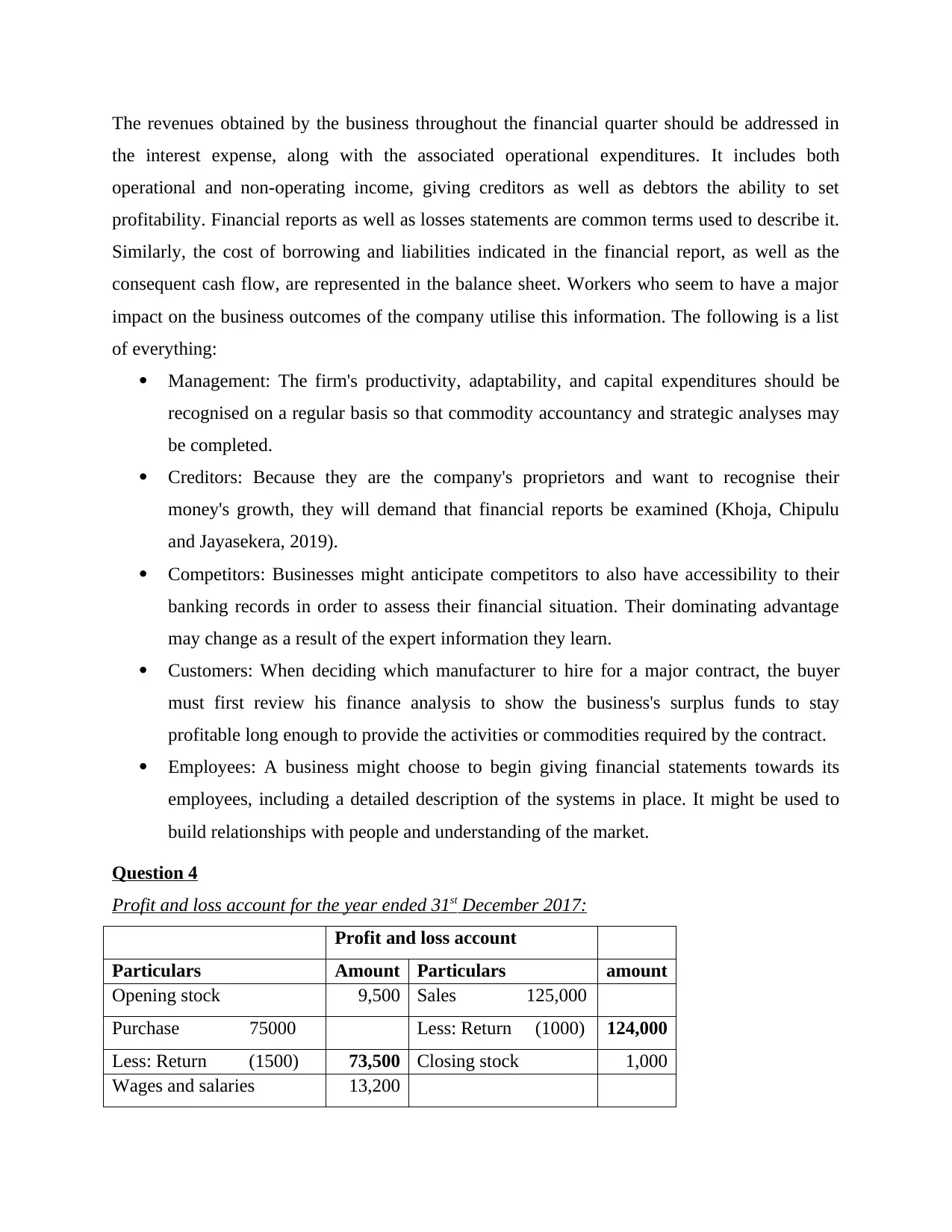
The revenues obtained by the business throughout the financial quarter should be addressed in
the interest expense, along with the associated operational expenditures. It includes both
operational and non-operating income, giving creditors as well as debtors the ability to set
profitability. Financial reports as well as losses statements are common terms used to describe it.
Similarly, the cost of borrowing and liabilities indicated in the financial report, as well as the
consequent cash flow, are represented in the balance sheet. Workers who seem to have a major
impact on the business outcomes of the company utilise this information. The following is a list
of everything:
Management: The firm's productivity, adaptability, and capital expenditures should be
recognised on a regular basis so that commodity accountancy and strategic analyses may
be completed.
Creditors: Because they are the company's proprietors and want to recognise their
money's growth, they will demand that financial reports be examined (Khoja, Chipulu
and Jayasekera, 2019).
Competitors: Businesses might anticipate competitors to also have accessibility to their
banking records in order to assess their financial situation. Their dominating advantage
may change as a result of the expert information they learn.
Customers: When deciding which manufacturer to hire for a major contract, the buyer
must first review his finance analysis to show the business's surplus funds to stay
profitable long enough to provide the activities or commodities required by the contract.
Employees: A business might choose to begin giving financial statements towards its
employees, including a detailed description of the systems in place. It might be used to
build relationships with people and understanding of the market.
Question 4
Profit and loss account for the year ended 31st December 2017:
Profit and loss account
Particulars Amount Particulars amount
Opening stock 9,500 Sales 125,000
Purchase 75000 Less: Return (1000) 124,000
Less: Return (1500) 73,500 Closing stock 1,000
Wages and salaries 13,200
the interest expense, along with the associated operational expenditures. It includes both
operational and non-operating income, giving creditors as well as debtors the ability to set
profitability. Financial reports as well as losses statements are common terms used to describe it.
Similarly, the cost of borrowing and liabilities indicated in the financial report, as well as the
consequent cash flow, are represented in the balance sheet. Workers who seem to have a major
impact on the business outcomes of the company utilise this information. The following is a list
of everything:
Management: The firm's productivity, adaptability, and capital expenditures should be
recognised on a regular basis so that commodity accountancy and strategic analyses may
be completed.
Creditors: Because they are the company's proprietors and want to recognise their
money's growth, they will demand that financial reports be examined (Khoja, Chipulu
and Jayasekera, 2019).
Competitors: Businesses might anticipate competitors to also have accessibility to their
banking records in order to assess their financial situation. Their dominating advantage
may change as a result of the expert information they learn.
Customers: When deciding which manufacturer to hire for a major contract, the buyer
must first review his finance analysis to show the business's surplus funds to stay
profitable long enough to provide the activities or commodities required by the contract.
Employees: A business might choose to begin giving financial statements towards its
employees, including a detailed description of the systems in place. It might be used to
build relationships with people and understanding of the market.
Question 4
Profit and loss account for the year ended 31st December 2017:
Profit and loss account
Particulars Amount Particulars amount
Opening stock 9,500 Sales 125,000
Purchase 75000 Less: Return (1000) 124,000
Less: Return (1500) 73,500 Closing stock 1,000
Wages and salaries 13,200
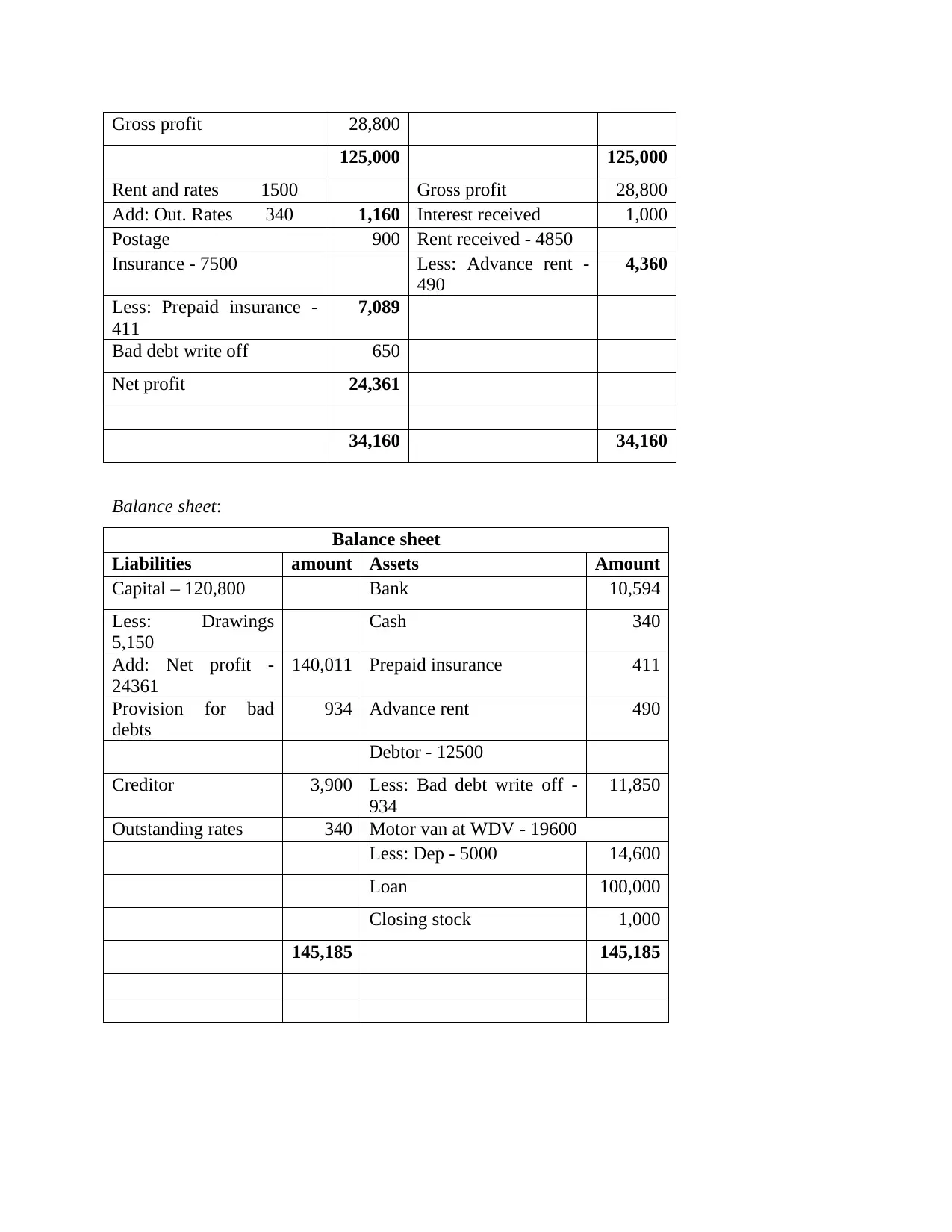
Gross profit 28,800
125,000 125,000
Rent and rates 1500 Gross profit 28,800
Add: Out. Rates 340 1,160 Interest received 1,000
Postage 900 Rent received - 4850
Insurance - 7500 Less: Advance rent -
490
4,360
Less: Prepaid insurance -
411
7,089
Bad debt write off 650
Net profit 24,361
34,160 34,160
Balance sheet:
Balance sheet
Liabilities amount Assets Amount
Capital – 120,800 Bank 10,594
Less: Drawings
5,150
Cash 340
Add: Net profit -
24361
140,011 Prepaid insurance 411
Provision for bad
debts
934 Advance rent 490
Debtor - 12500
Creditor 3,900 Less: Bad debt write off -
934
11,850
Outstanding rates 340 Motor van at WDV - 19600
Less: Dep - 5000 14,600
Loan 100,000
Closing stock 1,000
145,185 145,185
125,000 125,000
Rent and rates 1500 Gross profit 28,800
Add: Out. Rates 340 1,160 Interest received 1,000
Postage 900 Rent received - 4850
Insurance - 7500 Less: Advance rent -
490
4,360
Less: Prepaid insurance -
411
7,089
Bad debt write off 650
Net profit 24,361
34,160 34,160
Balance sheet:
Balance sheet
Liabilities amount Assets Amount
Capital – 120,800 Bank 10,594
Less: Drawings
5,150
Cash 340
Add: Net profit -
24361
140,011 Prepaid insurance 411
Provision for bad
debts
934 Advance rent 490
Debtor - 12500
Creditor 3,900 Less: Bad debt write off -
934
11,850
Outstanding rates 340 Motor van at WDV - 19600
Less: Dep - 5000 14,600
Loan 100,000
Closing stock 1,000
145,185 145,185
⊘ This is a preview!⊘
Do you want full access?
Subscribe today to unlock all pages.

Trusted by 1+ million students worldwide
1 out of 26
Related Documents
Your All-in-One AI-Powered Toolkit for Academic Success.
+13062052269
info@desklib.com
Available 24*7 on WhatsApp / Email
![[object Object]](/_next/static/media/star-bottom.7253800d.svg)
Unlock your academic potential
Copyright © 2020–2025 A2Z Services. All Rights Reserved. Developed and managed by ZUCOL.





